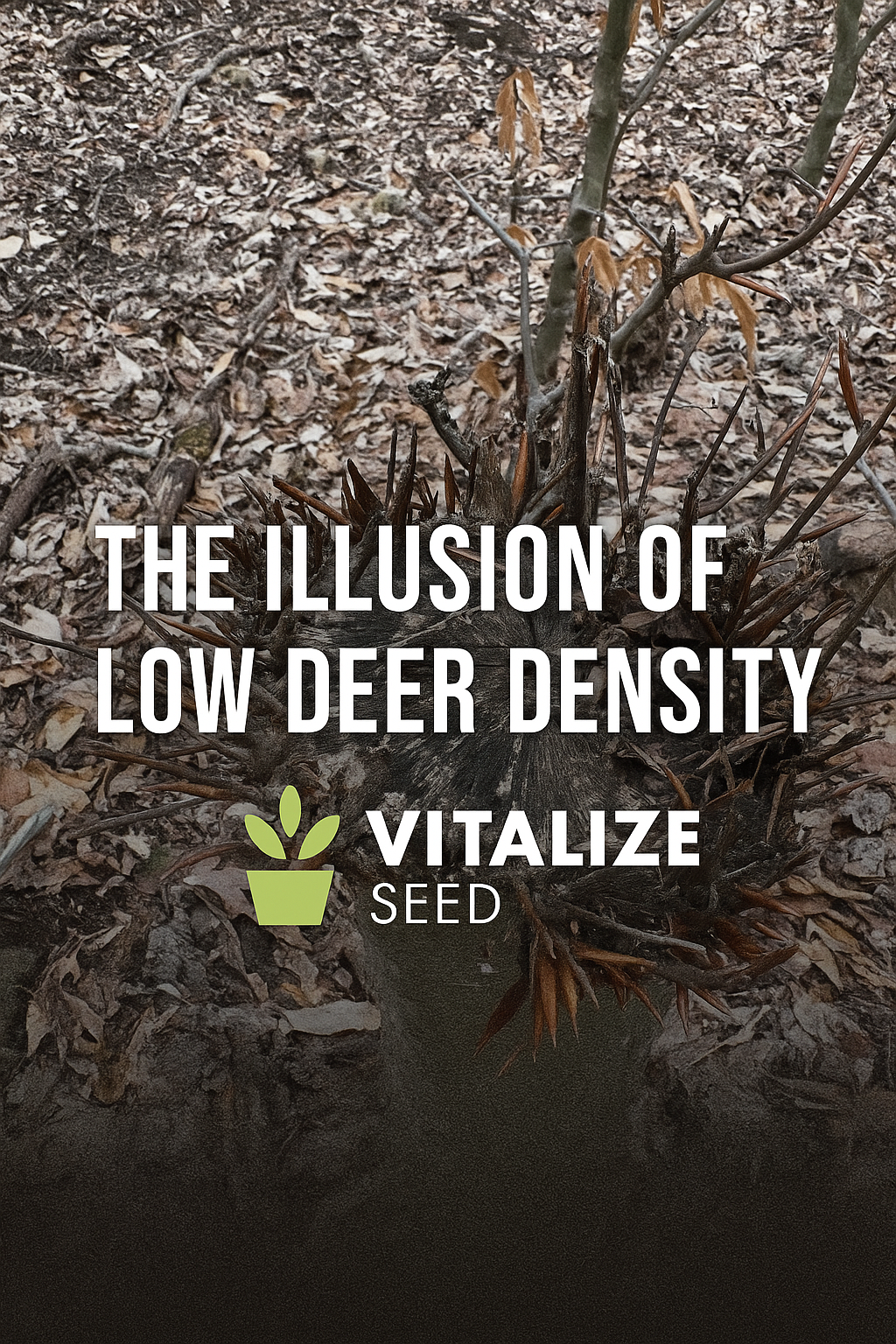
The Illusion of Low Deer Density - Why “Not Seeing Deer” Doesn’t Mean You Have Too Few
Share
Every season, someone says,
“We don’t have that many deer. I barely saw any.”
But the woods tell a different story.
In thick, hilly timber, deer can be hard to see and still be absolutely pounding the habitat. Your food plots, timber cuts, and browse all reveal the truth faster than your cameras do.
This is how we combined hunting observations, trail cameras, woods surveys, neighbor input, and our forester’s expertise to realize we were dealing with more deer than the habitat could sustain, even after planting 14+ acres of food plots twice a year and doing significant TSI work.
1. The Habitat Work
| Management Type | Acres | Notes |
|---|---|---|
| Annual food plots (NitroBoost / Carbon Load) | 14 | Spring and fall every year |
| Broadcast plots | 1–3 | Edge and interior seeding for supplemental feed |
| Perennial clover and alfalfa | ~2–3 | About 1 acre of alfalfa, 1.25-acre clover, and 1 acre of trails and yard overseeded |
| Cull tree and TSI cuts | 17 | Sunlight and browse release, plus ongoing expansion |
| Midstory removal | 6 | Opened canopy for regeneration |
| Edge feathering | Nearly all 14 acres of drilled plots | Softened field transitions, with more work to do |
| Clearcut | 3 | Early successional thicket, now heavily browsed |
| Invasive Tree-of-Heaven removal | ~18 | Chemical removal increased native browse |
| New TSI bottom project | 19 | Currently underway, with 2 acres cut so far. |
Across more than 40 acres of habitat projects, food and structure have been layered for balance and regeneration. Yet despite this diversity, browse pressure continues to intensify.
2. What the Woods Are Actually Showing
- Terminal buds clipped on beech and hickory, limiting regrowth to under 18 inches.
- Brambles browsed as thick as a person’s pinky finger.
- Non-desirable species are being eaten
- High-value plants like pokeweed grow but are topped immediately, looking like they were hit with a string trimmer —alive but producing nothing above a few inches.
When deer are eating stems that thick and resorting to low-value species, the land isn’t balanced. That pattern reflects sustained overpressure.
3. Neighbor and Regional Observations
This isn’t just a single property issue.
Neighbors managing several hundred acres around us have shared similar findings. Many plant ten or more acres of food plots, run multiple feeders, and still report heavy browse pressure and steady nighttime deer activity.
These conversations confirmed what the woods already showed: deer density and browse intensity are high across the broader landscape, not just our farm.
Recent drone-based deer density research has echoed these same findings across much of the Midwest and Appalachian foothills:
“Most landowners have more deer than they realize because deer density and visibility don’t correlate well in forested terrain.”
In other words, the herd is larger than what we see from the stand.
4. Our Harvest History
| Year | Adult Does Taken | Habitat Response |
|---|---|---|
| Year 1 | 8–9 | Slight relief; plots lasted longer |
| Year 2 | 3 | Deer rebounded quickly; browse worsened |
| Year 3 | Target 8–10 | Conditions still indicate overpressure |
Even with aggressive work, three does wasn’t enough, and even nine didn’t yield long-term relief.
5. Why the Herd Rebounds So Fast
- Immigration from neighboring low-harvest tracts quickly refills the gap.
- Compensatory reproduction increases fawn recruitment.
- Well-fed female fawns around 70 pounds breed their first winter.
- Mild winters and abundant food reduce natural mortality.
Studies show 25 to 50 percent of female fawns can breed in rich environments, allowing the herd to rebound 30 percent in a single cycle.
Deer Recovery Example
| Year | Event | Relative Density | Harvest Rate | Key Effect |
|---|---|---|---|---|
| 0 | Peak density | ~70+ DPSM | — | Severe browse and overpressure |
| 1 | Heavy harvest (big push) | ≈ 50 DPSM | ~25% removal | Noticeable short-term relief; browse temporarily subsides |
| 2 | Reduced harvest | ≈ 60–65 DPSM | ~10% removal | Recruitment and immigration begin filling the gap within one season |
| 3 | Moderate harvest | ≈ 68–70 DPSM | ~15% removal | Density rebounds despite continued hunting; browse damage returns |
| 4 | Continued mild harvest | ≈ 72–75+ DPSM | ~10–15% removal | Population surpasses pre-cull levels; regeneration stalls again |
Interpretation:
Even with continued harvest, if the effort is lower than what’s needed to match recruitment, the herd rebounds. Once a property lowers doe harvest intensity after an initial heavy year, natural reproduction and immigration offset removals within two to three years.
In heavily managed areas with abundant food, cover, and winter survival, deer numbers often exceed pre-harvest density within three years of the initial cull.
Consistency matters more than intensity. One big year doesn’t fix it; steady, balanced harvest pressure does.
6. Feeders and Food Plots Hide the Real Pressure
When every property provides groceries, deer survival skyrockets.
Even if the county average is 35 to 40 deer per square mile, your functional density, meaning the number actually living off your habitat, can be double that.
This creates a temporary, artificially inflated carrying capacity. As long as food plots, feeders, and agricultural crops are abundant, deer appear healthy, and pressure feels manageable. But when those resources are gone, such as during late winter or drought years, deer are forced back onto the native habitat. That is when the true carrying capacity of the land is exposed!
7. Key Management Takeaways
- Manage by habitat, not sightings. The plants will always tell the truth.
- Set a realistic harvest quota for your property each season and do your best to meet it.
- Evaluate the results the next year. If browsing is still heavy or plots are struggling, increase your target slightly. If regeneration improves, maintain or ease off.
- Track dressed weights, lactation signs, and photo comparisons of browse to see how the herd is responding over time.
- Stay consistent year after year. A single big harvest season rarely solves the problem.
- Work with neighbors and communicate openly. Shared goals and steady effort create true, landscape-level regeneration.
8. The Plants Don’t Lie
When non-preferred browse is chewed, brambles are bitten thick as your pinky, and pokeweed keeps getting topped, it’s not a mild imbalance.
It’s a habitat under sustained strain.
That doesn’t mean we don’t have enough deer to hunt. It means we have more mouths than our habitat can sustain.
9. Layering Observations for Smarter Harvest
- Hunting: Multiple doe groups, early fawn recruitment, and constant evening feeding indicate excess population.
- Trail Cameras: High nighttime counts across multiple sites confirm real density.
- Browse Surveys: Topped pokeweed, bitten brambles, and stunted sprouts are clear gauges.
- Forester Input: If regeneration is failing, the answer is simple: harvest harder.
- Neighbor Input: Consistent reports of high deer use across surrounding farms confirm a broader over-density issue.
When all of these align, the right quota is obvious. For properties like this, with heavy food, mixed terrain, and neighboring low harvest, 1-2 doe or more per 100 acres is digestible.
10. Final Thought
“If your cameras, your stands, your woods, your neighbors, and your forester are all saying the same thing, believe the habitat, not the quiet evenings. The plants don’t lie.”
This blog is meant to help you look at your own property and think through how deer density, habitat management, and hunting all interact. It’s not meant to say you should or shouldn’t shoot does. Every property, neighborhood, and habitat type is unique. My hope is that this helps you better understand how to evaluate the land, the browse, and the herd in front of you.
Shoot more deer, plant more food, or often, do both.
Albert
